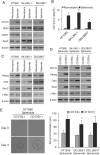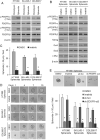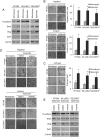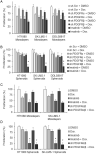Platelet-derived growth factor receptor-α and -β promote cancer stem cell phenotypes in sarcomas
- PMID: 29915281
- PMCID: PMC6006341
- DOI: 10.1038/s41389-018-0059-1
Platelet-derived growth factor receptor-α and -β promote cancer stem cell phenotypes in sarcomas
Retraction in
-
Retraction Note: Platelet-derived growth factor receptor-α and -β promote cancer stem cell phenotypes in sarcomas.Oncogenesis. 2024 May 29;13(1):19. doi: 10.1038/s41389-024-00520-7. Oncogenesis. 2024. PMID: 38811545 Free PMC article. No abstract available.
Abstract
Sarcomas are malignant tumors derived from mesenchymal tissues and may harbor a subset of cells with cancer stem-like cell (CSC) properties. Platelet-derived growth factor receptors α and β (PDGFR-α/β) play an important role in the maintenance of mesenchymal stem cells. Here we examine the role of PDGFR-α/β in sarcoma CSCs. PDGFR-α/β activity and the effects of PDGFR-α/β inhibition were examined in 3 human sarcoma cell lines using in vitro assays and mouse xenograft models. In all three cell lines, PDGFR-α/β activity was significantly higher in cells grown as spheroids (to enrich for CSCs) and in cells sorted for CD133 expression (a marker of sarcoma CSCs). Self-renewal transcription factors Nanog, Oct4, and Slug and epithelial-to-mesenchymal transition (EMT) proteins Snail, Slug, and Zeb1 were also significantly higher in spheroids cells and CD133(+) cells. Spheroid cells and CD133(+) cells demonstrated 2.9- to 4.2-fold greater migration and invasion and resistance to doxorubicin chemotherapy. Inhibition of PDGFR-α/β in CSCs using shRNA or pharmacologic inhibitors reduced expression of certain self-renewal and EMT proteins, reduced spheroid formation by 74-82%, reduced migration and invasion by 73-80%, and reversed chemotherapy resistance. In mouse xenograft models, combining PDGFR-α/β inhibition (using shRNA or imatinib) with doxorubicin had a more-than-additive effect in blocking tumor growth, with enhanced apoptosis, especially in CD133(+) cells. These results indicate that PDGFR-α/β activity is upregulated in sarcoma CSCs and promote CSC phenotypes including migration, invasion, and chemotherapy resistance. Thus, the PDGFR-α/β pathway represents a new potential therapeutic target to reduce metastatic potential and increase chemosensitivity.
Conflict of interest statement
The authors declare that they have no conflict of interest.
Figures






Similar articles
-
PI3K/Akt pathway and Nanog maintain cancer stem cells in sarcomas.Oncogenesis. 2021 Jan 19;10(1):12. doi: 10.1038/s41389-020-00300-z. Oncogenesis. 2021. Retraction in: Oncogenesis. 2024 May 29;13(1):18. doi: 10.1038/s41389-024-00519-0. PMID: 33468992 Free PMC article. Retracted.
-
PIK3R3, part of the regulatory domain of PI3K, is upregulated in sarcoma stem-like cells and promotes invasion, migration, and chemotherapy resistance.Cell Death Dis. 2021 Jul 29;12(8):749. doi: 10.1038/s41419-021-04036-5. Cell Death Dis. 2021. Retraction in: Cell Death Dis. 2024 Mar 19;15(3):226. doi: 10.1038/s41419-024-06609-6. PMID: 34321458 Free PMC article. Retracted.
-
ERK1/2-Nanog signaling pathway enhances CD44(+) cancer stem-like cell phenotypes and epithelial-to-mesenchymal transition in head and neck squamous cell carcinomas.Cell Death Dis. 2020 Apr 23;11(4):266. doi: 10.1038/s41419-020-2448-6. Cell Death Dis. 2020. Retraction in: Cell Death Dis. 2024 Mar 15;15(3):219. doi: 10.1038/s41419-024-06608-7. PMID: 32327629 Free PMC article. Retracted.
-
Morphological and molecular characteristics of spheroid formation in HT-29 and Caco-2 colorectal cancer cell lines.Cancer Cell Int. 2021 Apr 13;21(1):204. doi: 10.1186/s12935-021-01898-9. Cancer Cell Int. 2021. PMID: 33849536 Free PMC article.
-
Triptolide inhibits CD133+ /CD44+ colon cancer stem cell growth and migration through triggering apoptosis and represses epithelial-mesenchymal transition via downregulating expressions of snail, slug, and twist.J Cell Biochem. 2020 Jun;121(5-6):3313-3324. doi: 10.1002/jcb.29602. Epub 2020 Jan 6. J Cell Biochem. 2020. PMID: 31904143
Cited by
-
The gate to metastasis: key players in cancer cell intravasation.FEBS J. 2022 Aug;289(15):4336-4354. doi: 10.1111/febs.16046. Epub 2021 Jun 18. FEBS J. 2022. PMID: 34077633 Free PMC article. Review.
-
Comprehensive analysis of a novel cuproptosis-related lncRNA signature associated with prognosis and tumor matrix features to predict immunotherapy in soft tissue carcinoma.Front Genet. 2022 Dec 7;13:1063057. doi: 10.3389/fgene.2022.1063057. eCollection 2022. Front Genet. 2022. PMID: 36568384 Free PMC article.
-
Pediatric cancer-pathology and microenvironment influence: a perspective into osteosarcoma and non-osteogenic mesenchymal malignant neoplasms.Discov Oncol. 2024 Aug 18;15(1):358. doi: 10.1007/s12672-024-01240-5. Discov Oncol. 2024. PMID: 39154307 Free PMC article. Review.
-
Nanoplateletsomes restrain metastatic tumor formation through decoy and active targeting in a preclinical mouse model.Acta Pharm Sin B. 2022 Aug;12(8):3427-3447. doi: 10.1016/j.apsb.2022.01.005. Epub 2022 Jan 12. Acta Pharm Sin B. 2022. PMID: 35967283 Free PMC article.
-
An integrative investigation on significant mutations and their down-stream pathways in lung squamous cell carcinoma reveals CUL3/KEAP1/NRF2 relevant subtypes.Mol Med. 2020 May 20;26(1):48. doi: 10.1186/s10020-020-00166-2. Mol Med. 2020. PMID: 32434476 Free PMC article.
References
-
- Van Glabbeke M, et al. Prognostic factors for the outcome of chemotherapy in advanced soft tissue sarcoma: an analysis of 2,185 patients treated with anthracycline-containing first-line regimens--a European Organization for Research and Treatment of Cancer Soft Tissue and Bone Sarcoma Group Study. J. Clin. Oncol. 1999;17:150–157. doi: 10.1200/JCO.1999.17.1.150. - DOI - PubMed
Publication types
Grants and funding
LinkOut - more resources
Full Text Sources
Other Literature Sources
Research Materials
Miscellaneous

